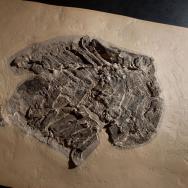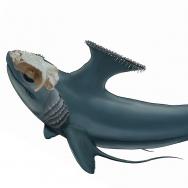Paleontologists at the University of Chicago have discovered the first detailed fossil of a hagfish, the slimy, eel-like carrion feeders of the ocean. The 100-million-year-old fossil helps answer questions about when these ancient, jawless fish branched off the evolutionary tree from the lineage that gave rise to modern-day jawed vertebrates, including bony fish and humans.
The fossil, named Tethymyxine tapirostrum, is a 12-inch-long fish embedded in a slab of Cretaceous period limestone from Lebanon. It fills a 100-million-year gap in the fossil record and shows that hagfish are more closely related to the blood-sucking lamprey than to other fishes. This means that both hagfish and lampreys evolved their eel-like body shape and strange feeding systems after they branched off from the rest of the vertebrate line of ancestry about 500 million years ago.
“This is a major reorganization of the family tree of all fish and their descendants. This allows us to put an evolutionary date on unique traits that set hagfish apart from all other animals,” said Tetsuto Miyashita, a Chicago Fellow in the Department of Organismal Biology and Anatomy at UChicago, who led the research.
The findings are published this week in the Proceedings of the National Academy of Sciences. The fossil is the latest groundbreaking discovery from UChicago’s world-renowned paleontology program, whose field-defining research ranges from millions-of-years-old fossils to the living, breathing creatures descended from them.
The slimy dead giveaway
Modern-day hagfish are known for their bizarre, nightmarish appearance and unique defense mechanism. They don’t have eyes, or jaws or teeth to bite with, but instead use a spiky tongue-like apparatus to rasp flesh off dead fish and whales at the bottom of the ocean. When harassed, they can instantly turn the water around them into a cloud of slime, clogging the gills of would-be predators.
This ability to produce slime is what gave away the Tethymyxine fossil. Miyashita used an imaging technology called synchrotron scanning at Stanford University to identify chemical traces of soft tissue that were left behind in the limestone when the hagfish fossilized. These soft tissues are rarely preserved, which is why there are so few examples of ancient hagfish relatives to study.
The scanning picked up a signal for keratin, the same material that makes up fingernails in humans. Keratin, as it turns out, is a crucial part of what makes the hagfish slime defense so effective. Hagfish have a series of glands along their bodies that produce tiny packets of tightly-coiled keratin fibers, lubricated by mucus-y goo. When these packets hit seawater, the fibers explode and trap the water within, turning everything into shark-choking slop. The fibers are so strong that when dried out they resemble silk threads; they’re even being studied as possible biosynthetic fibers to make clothes and other materials.
Miyashita and his colleagues found more than a hundred concentrations of keratin along the body of the fossil, meaning that the ancient hagfish probably evolved its slime defense when the seas included fearsome predators such as plesiosaurs and ichthyosaurs that we no longer see today.
“We now have a fossil that can push back the origin of the hagfish-like body plan by hundreds of millions of years,” Miyashita said. “Now, the next question is how this changes our view of the relationships between all these early fish lineages.”
Shaking up the vertebrate family tree
Features of the new fossil help place hagfish and their relatives on the vertebrate family tree. In the past, scientists have disagreed about where they belonged, depending on how they tackled the question. Those who rely on fossil evidence alone tend to conclude that hagfish are so primitive that they are not even vertebrates. This implies that all fishes and their vertebrate descendants had a common ancestor that—more or less—looked like a hagfish.
But those who work with genetic data argue that hagfish and lampreys are more closely related to each other. This suggests that modern hagfish and lampreys are the odd ones out in the family tree of vertebrates. In that case, the primitive appearance of hagfish and lampreys is deceptive, and the common ancestor of all vertebrates was probably something more conventionally fish-like.
Miyashita’s work reconciles these two approaches, using physical evidence of the animal’s anatomy from the fossil to come to the same conclusion as the geneticists: that the hagfish and lampreys should be grouped separately from the rest of fishes.
“In a sense, this resets the agenda of how we understand these animals,” said Michael Coates, professor of organismal biology and anatomy at UChicago and a co-author of the new study. “Now we have this important corroboration that they are a group apart. Although they're still part of vertebrate biodiversity, we now have to look at hagfish and lampreys more carefully, and recognize their apparent primitiveness as a specialized condition.
One of the world’s leading evolutionary biologists, Coates has discovered numerous fossils of ancient fish that have transformed our understanding of the early vertebrate family tree. Most recently, he published a 2017 study about a 280 million-year-old fossil of a chimaera, which led light on the early development of these shark-like fish; and in 2018, he described a 385 million-year-old primitive shark from Germany that found sharks aren’t as primitive as generally assumed.
Paleontologists have increasingly used sophisticated imaging techniques in the past few years, but Miyashita’s research is one of a handful so far to use synchrotron scanning to identify chemical elements in a fossil. While it was crucial to detect anatomical structures in the hagfish fossil, he believes it can also be a useful tool to help scientists detect paint or glue used to embellish a fossil or even outright forge a specimen. Any attempt to spice up a fossil specimen leaves chemical fingerprints that light up like holiday decorations in a synchrotron scan.
“I’m impressed with what Tetsuto has marshaled here,” Coates said. “He's maxed out all the different techniques and approaches that can be applied to this fossil to extract information from it, to understand it and to check it thoroughly.”
Citation: “A Hagfish from the Cretaceous Tethys Sea and a Reconciliation of the Morphological-Molecular Conflict in Early Vertebrate Phylogeny,” Proceedings of the National Academy of Sciences. Jan. 21, 2019. DOI: 10.1073/pnas.1814794116
Funding: National Science Foundation and the National Science and Engineering Research Council (Canada)
—Story originally appeared on The Forefront

